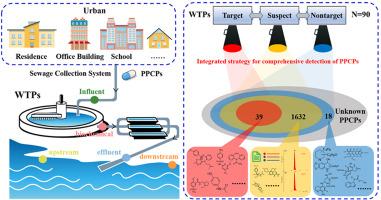Comprehensive Screening and Occurrence-Removal Assessment of Pharmaceuticals and Personal Care Products in Wastewater Treatment Plants Using High-Resolution Mass Spectrometry
IF 7.3
2区 环境科学与生态学
Q1 ENVIRONMENTAL SCIENCES
引用次数: 0
Abstract
The extensive use of pharmaceuticals and personal care products (PPCPs) has led to their increasing presence in urban wastewater. The discharge of these contaminants into natural water bodies poses a threat to human health and the ecological environment. This study developed an integrated targeted, suspect, and functional group-dependent screening method for PPCPs via UHPLC-Q-Orbitrap HRMS, and this method was applied for investigation of occurrence of known and unknown PPCPs in 90 water samples from 18 wastewater treatment plants (WWTPs) located along the Yangtze River. The results demonstrated that 39 target PPCPs were detected in at least one of the analyzed samples, and it was worth noting that sulfadimethoxine (SDM) exhibited a detection frequency of 100% with a concentration range of 1.48 to 67,400 ng/L. We also observed that water samples from different treatment processes exhibited different contamination profiles of PPCPs. On the basis of concentrations of PPCPs detected in water samples, the overall removal efficiency of PPCPs was preliminarily calculated to be 85.3% for the WWTPs. The treatment processes had a significant effect on the overall removal of the 39 PPCPs (Mann–Whitney U test, p < 0.001). Through suspect screening, a total of 1632 compounds were detected, with three successfully identified; through nontarget screening, 18 unknown PPCPs were identified. This study provided an efficient technique for comprehensive screening of known and unknown PPCPs in environments, and further explored the concentration differences of PPCPs during various treatment processes in WWTPs.

高解析度质谱技术在污水处理厂的药物及个人护理用品的综合筛选及发生-去除评估
药品和个人护理产品(PPCPs)的广泛使用导致它们在城市废水中的存在越来越多。这些污染物排放到自然水体中,对人类健康和生态环境构成威胁。本研究利用UHPLC-Q-Orbitrap HRMS建立了PPCPs的靶向、可疑和功能基依赖综合筛选方法,并应用该方法对长江流域18家污水处理厂90份水样中已知和未知PPCPs的发生情况进行了调查。结果表明,在至少一种分析样品中检测到39种目标PPCPs,值得注意的是,磺胺二甲氧嘧啶(SDM)的检测频率为100%,浓度范围为1.48 ~ 67,400 ng/L。我们还观察到,不同处理过程的水样显示出不同的PPCPs污染概况。根据水样中PPCPs的检测浓度,初步计算出污水处理厂对PPCPs的整体去除率为85.3%。处理过程对39种ppcp的总体去除有显著影响(Mann-Whitney U检验,p < 0.001)。通过可疑筛选,共检测到1632个化合物,成功鉴定3个;通过非靶标筛选,鉴定出18个未知PPCPs。本研究为综合筛选环境中已知和未知PPCPs提供了一种有效的技术,并进一步探讨了污水处理厂不同处理过程中PPCPs的浓度差异。
本文章由计算机程序翻译,如有差异,请以英文原文为准。
求助全文
约1分钟内获得全文
求助全文
来源期刊

Environmental Pollution
环境科学-环境科学
CiteScore
16.00
自引率
6.70%
发文量
2082
审稿时长
2.9 months
期刊介绍:
Environmental Pollution is an international peer-reviewed journal that publishes high-quality research papers and review articles covering all aspects of environmental pollution and its impacts on ecosystems and human health.
Subject areas include, but are not limited to:
• Sources and occurrences of pollutants that are clearly defined and measured in environmental compartments, food and food-related items, and human bodies;
• Interlinks between contaminant exposure and biological, ecological, and human health effects, including those of climate change;
• Contaminants of emerging concerns (including but not limited to antibiotic resistant microorganisms or genes, microplastics/nanoplastics, electronic wastes, light, and noise) and/or their biological, ecological, or human health effects;
• Laboratory and field studies on the remediation/mitigation of environmental pollution via new techniques and with clear links to biological, ecological, or human health effects;
• Modeling of pollution processes, patterns, or trends that is of clear environmental and/or human health interest;
• New techniques that measure and examine environmental occurrences, transport, behavior, and effects of pollutants within the environment or the laboratory, provided that they can be clearly used to address problems within regional or global environmental compartments.
 求助内容:
求助内容: 应助结果提醒方式:
应助结果提醒方式:


